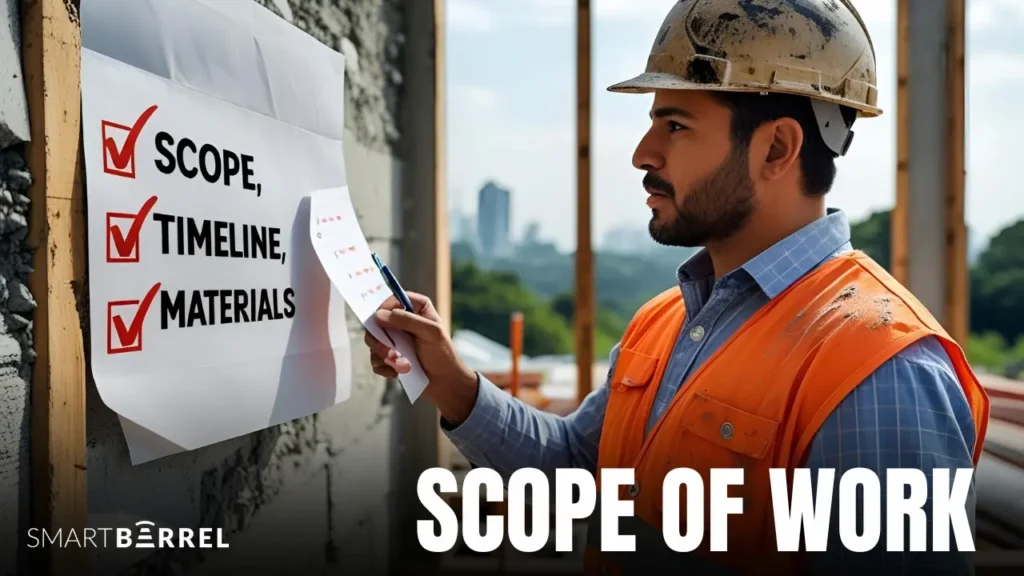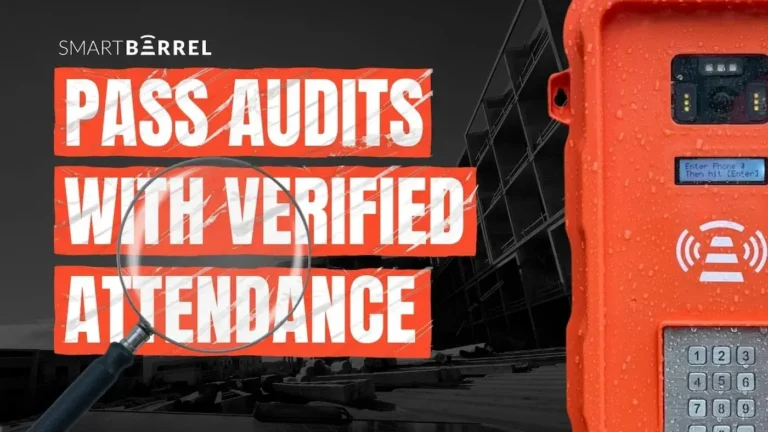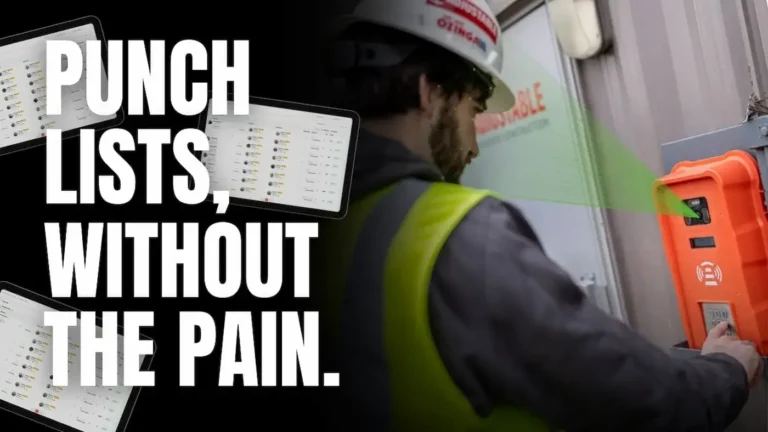Creating a detailed and accurate Scope of Work (SOW) is one of the most important steps in any construction project. It defines exactly what needs to be done, how it should be done, and who is responsible for each part of the job.
A well-defined SOW is the cornerstone of success in construction projects. It aligns expectations, minimizes risks, and keeps all stakeholders on the same page. While these may seem like straightforward goals, their absence is at the root of many common issues in modern construction.
In the coming sections, we’ll walk through what a scope of work is, why it matters, and how you can write a construction scope of work that keeps your subcontractors in line and allows your project to run smoothly and dispute-free.
What Is A Construction Scope Of Work?
In simple terms, a construction scope of work is a detailed document that outlines the specific tasks, deliverables, timelines, and standards for a construction project. It breaks down the project’s goals into actionable steps.
When people ask, “What is SOW in construction?” — the answer is that it’s a project’s game plan. The ысщзу ща цщкл clarifies expectations for all parties involved: owners, general contractors, subcontractors, and inspectors.
Whether you’re managing a commercial buildout or working on the scope of work for construction of a building, your scope of work ensures everyone’s pulling in the same direction.
Why The Construction Scope of Work Matters?
The scope of work isn’t just paperwork. It’s a project safeguard. Here’s why a clear construction scope of work is essential:
- Prevents scope creep: Imagine you’re managing the construction of a new office building. Midway through, the client decides they want a rooftop garden added. Without a clear scope of work, this change could throw off your project timeline and budget. Scope creep has a direct and significant impact on your project’s success. A carefully designed scope of workcan help you keep it at bay.
- Improves communication: Poor field communication can cost you big, and a well-defined SOW can save you from that loss. Let’s say you’re working on a residential development project with several subcontractors. One for plumbing, another for electrical work, and a third for drywall. If the scope of work clearly defines the responsibilities and timeline for each crew, everyone knows exactly what their role is. This clarity keeps communication clear and prevents delays caused by confusion.
- Reduces disputes: In a scenario where you’re managing a large warehouse project, if one subcontractor claims they weren’t paid because the general contractor never provided the required materials, but the general contractor says the materials were delivered on time, a detailed scope of work resolves the conflict. With clear guidelines, deadlines, and material specifications written into the SOW, it’s easier to pinpoint who’s responsible for what and address any issues without unnecessary back-and-forth.
- Keeps budgets on track: Cost control is one of the hardest jobs on a jobsite. You can have the best time management and labor management systems in place. However, all of that would mean very little without carefully tracking the exact specifications of the project. Imagine your flooring contractor suddenly decides to upgrade the flooring on the entire project. That would cost you upwards of thousands of dollars, and the only way to avoid it is an ironclad SOW that has all the details. This would mean no deviation from the plan down the line, or at least you won’t be liable for it.
- Aligns teams: Consider a construction project where the general contractor is handling site preparation, while a specialized team is doing the electrical work. Without a clear scope of work, there could be confusion about the exact timing of the site prep and when the electrical crew can begin. By specifying milestones and team responsibilities, the scopw of work ensures that everyone knows when to step in, and that there’s no overlap or delays in completing tasks.
These are only a few examples. A solid construction scope of work can save you from a lot of headaches, and without it, even the simplest builds can turn messy. All it needs is one thing to go wrong at any point.
Get Control of Your Time Tracking
Components Of A Construction Scope Of Work
A good construction scope doesn’t have to be fancy — it just needs to be clear. Here are the essential components:
Project Overview
This is your “elevator pitch” for the project. What are you building, and why? Whether it’s a new office building or a warehouse expansion, this section sets the tone and gives everyone involved a shared understanding of the project’s purpose.
Objectives
What does success look like? This is where you define the end goals. For example, is it meeting deadlines, staying under budget, or achieving specific quality standards? Setting clear objectives gives the entire team something to work toward, and it keeps everyone on track to deliver results.
Tasks & Deliverables
This is the meat of your scope. What’s expected? Break down every task — from laying foundations to final inspections. Don’t forget the materials, labor, and tools involved. With the right tracking tools, you can keep every task under control and avoid costly surprises. See how SmartBarrel helps track tasks in real time.
Project Schedule
Timelines are everything in construction. This is where you specify when each task needs to be done. Who’s working on what, and when does it need to be completed? The more precise the schedule, the less room there is for confusion or delays.
Roles & Responsibilities
Clarify who’s in charge of what. Who’s overseeing the foundation work? Who handles the electrical wiring? A well-defined roles section prevents overlap and ensures each part of the job runs smoothly. You can have all the types of daily, weekly, and monthly progress reports. Clearly defined roles and accountability ensure that everyone is aware of what’s expected of them. This ultimately reduces blame-shifting and creates a more productive environment on the jobsite.
Payment Terms
Specify everything you can about labor costs, material costs, and everything else. Clearly define how payments will be made and when. Whether it is milestone-based or if there are retainers or final payments after completion? With clear payment terms, all stakeholders would remain on the same page.
Quality Standards
What’s the level of quality expected? Whether it’s adherence to safety codes or using top-notch materials, this section ensures the work meets agreed-upon standards. Think of it as a non-negotiable checklist for quality assurance.
Change Order Process
Construction is full of unexpected changes and those changes can have a direct impact on your job costing. This section outlines how any deviations from the original plan will be handled, who will be responsible for the additional costs, and how the change will be communicated to all parties involved.
Approvals & Sign-Offs
Who’s signing off on each stage? Who gets the final say? This ensures that before a task is marked as complete, it’s properly reviewed and approved. It helps eliminate any loose ends and ensures everything is up to standard before moving forward.
Whether you’re building a school or a strip mall, each of these should be part of your scope of work process.
How SmartBarrel Keeps Your Scope on Track
Even the most detailed construction scope of work won’t matter if it gets ignored in the field. That’s where SmartBarrel comes in. Our platform turns your written plan into real-time execution.
With SmartBarrel, you can:
- Track labor hours against the exact tasks in your construction project scope
- Assign cost codes tied to your scope ow work for better job costing and accountability
- Capture verified attendance with facial recognition so you know who’s doing what
- Monitor daily progress, delays, and safety incidents—all in one dashboard
Whether you’re managing a general contractor scope of work or tracking specialty crews, SmartBarrel helps your team stay aligned, stick to the plan, and execute each phase with clarity.
Get Control of Your Time Tracking
How To Write A Construction Scope Of Work: Step-by-Step Process
Given how important the scope of work is for construction, you can’t help but be intimidated by it. However, it’s easily manageable if you break it into bite-sized chunks and have all the details related to your project.
Here’s a step-by-step guide on what needs to be done:
Step 1: Gather All The Project Info
Before you start, you need to know the ins and outs of your project. Ensure that you have all the following details.
- Owner goals
- Design documents
- Site conditions
- Permits needed
- Budgets and timelines
These basic details are the foundation of your construction scope of work. Once you know the ‘why’, you’ll be on your way to success.
Step 2: Define The Project Objectives
What are you building, and why? Whether it’s a retail center or a high-rise, make sure the goals are clear. These should be concrete, measurable targets that define success. Being familiar with the SMART framework would be excellent for your construction planning. Each letter implies a certain characteristic your objective should have (Specific, Measurable, Achievable, Relevant, and Tangible).
Step 3: Break Down The Work
The next step is to break the project down into clear, manageable chunks. Here are a few examples:
- Site preparation
- Foundations
- Framing
- Electrical
- Plumbing
- HVAC
Now, identify what’s in scope and, just as importantly, what’s out of scope. Doing so would help you ensure that there are no surprises waiting for you at a later stage of the project.
Step 4: Assign Responsibilities
Who’s in charge of what? Clarify which tasks fall under the general contractor’s scope of work and which are assigned to subcontractors. This ensures everyone knows their role and avoids any confusion.
As a specialty or general contractor you can use the old age method of a RACI matrix, which allows you to identify Responsible, Accountable, Consulted, and Informed stakeholders for each task or stage of the project.
Step 5: Add Milestones And Schedule
The next step is to create a realistic project timeline, setting key dates and dependencies. These milestones should map out major tasks and their deadlines, ensuring that everything stays on track.
Step 6: Review Legal & Compliance Details
List any required codes, permits, safety regulations, or special requirements. Legal compliance is non-negotiable in construction, so make sure this is solid before moving forward.
Step 7: Set Payment And Approval Terms
Outline when and how payments will be made, and what milestones need to be approved before moving to the next stage. Clear payment terms help ensure everyone stays aligned.
Step 8: Review With All Parties
Before locking everything in, get feedback from the project team. Having input from all stakeholders ensures that nothing gets overlooked and that everyone is on the same page.
Common Mistakes To Avoid When Writing A Construction Scope of Work
When drafting your scope of work, clarity is key. Even small ambiguities can lead to big problems on the job site. Here are the most common mistakes to watch out for when writing a construction SOW:
1. Being Too Vague
Vagueness leads to confusion and mistakes on-site. General instructions like “Install HVAC system” leave too much to interpret. Instead, get specific:
“Install 3-ton rooftop HVAC unit with ductwork for 3,000 sq ft retail space, including air handler and exhaust vent installation.”
The more precise your language, the clearer your expectations are for everyone involved.
2. Leaving Out Exclusions
If something isn’t part of the deal, say so upfront. It’s easy to assume everyone knows what’s not included, but vague assumptions can lead to misunderstandings and disputes.
For example: “Exterior landscaping and parking lot paving are excluded from this contract.”
By clearly outlining exclusions, you eliminate any confusion later on. It’s just as important as defining what’s included.
3. Ignoring The Schedule
Without a timeline, you don’t have a real plan — just a vague idea. It’s tempting to think, “We’ll figure out the timing later,” but this is a recipe for delays and cost overruns.
A scope without a schedule isn’t just incomplete, it sets the stage for frustration. Make sure to include:
- Start and end dates
- Key milestones
- Dependencies between tasks
This way, the whole team knows when tasks are due, which helps you track progress and prevent delays.
4. Skipping Team Review
Never finalize your scope of work without getting input from your team. Whether it’s from the general contractor, subcontractors, or project managers, everyone needs to be on the same page.
Ignoring team feedback is a major risk. Your project could run into problems that could’ve been avoided. Ensure that all key stakeholders review the document before you lock it in. This collaboration ensures all angles are covered and prevents surprises down the road.
5. Failing To Update The Scope of Work
Plans change, and so should your scope. Failing to update your SOW after changes can lead to confusion, mistakes, and unmet expectations.
Get Control of Your Time Tracking
Execute Your Construction Projects Perfectly With Smartbarrel
Knowing how to write a construction scope of work is more than just creating a document. It’s a crucial project management tool that ensures your project stays on track, within budget, and free from conflict. But even the best-written scope of work won’t help if it isn’t executed correctly. That’s where SmartBarrel steps in.
SmartBarrel offers a comprehensive suite of tools designed to help you execute your construction projects flawlessly. From real-time labor tracking with our portable time clock and facial verification for attendance, to safety tracking and manpower tracking, SmartBarrel keeps everything in check. Our daily logs and cost coding tools allow you to track progress, monitor productivity, and ensure tasks are completed according to the schedule. All while reducing the chance of errors or miscommunication.
With access control and productivity tracking features, SmartBarrel ensures your team is where they need to be, doing what they need to do, and you can monitor it all in real-time. Whether you’re managing a large general contractor scope of work or just getting started with a new construction project scope, SmartBarrel helps you keep it moving with real-time labor tracking and productivity tools.
Ready to see how SmartBarrel helps you keep projects on scope and on schedule? Click here to set up a demo, and we’ll show you how it works.




